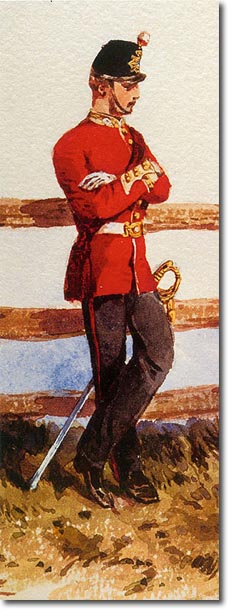|
|

 |
|
The tunic from 1856 to 1868 was single breasted and had slash flaps on the cuff with three gilt buttons and gold lace loops. Both the cuff and the flap were in the facing colour, buff for the 31st. There was a single gold lace border to the cuff and white piping along the top edge of the lace. Officers of the rank of major and above had two rows of gold lace as well as a gold lace border to the slash flap. The officer's rank was shown on the collar, an ensign having a star badge embroidered in silver, a lieutenant, a crown, and a captain a star and crown. These ranks had only one line of gold lace on the top of the buff collar, while field officers had gold on top and bottom, almost eclipsing the facing colour.
The shako worn by this officer is the pattern introduced in 1861, being made of cork and covered in blue cloth. Junior officers had no gold lace on this pattern but majors had a single row of lace around the top edge, and lieut-colonels two rows. The chin strap was black patent leather. On the front was a plain gilt star badge with 31 cut out of the centre. Above that was a ball tuft in a gilt socket. Flank companies were abolished in 1862 so all companies had a white over red tuft. The sword had a gilded hilt with a sword knot of gold and crimson finishing in an acorn shape. The scabbard, for field officers was brass and for other officers, black leather with gilt mounts. But the adjutant, seen here, had a steel scabbard. The sword belt was enamelled white leather with a gilt and silver clasp. Trousers were of Oxford mixture with a scarlet welt down the seam. The summer trousers, worn from 1st May until 14th Oct were dark blue, also with a scarlet welt. |
Armed Forces | Art and Culture | Articles | Biographies | Colonies | Discussion | Glossary | Home | Library | Links | Map Room | Sources and Media | Science and Technology | Search | Student Zone | Timelines | TV & Film | Wargames
